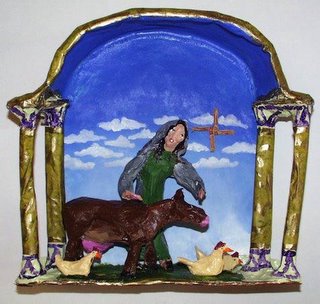CELTIC GROUNDHOG?


I was reading something about Celtic spirituality and noticed again that St. Brigid’s Day is celebrated on February 2nd. That’s also Groundhog Day. Oh, how interesting! So, I did some looking around to find out more. It is not – as I had assumed – a coincidence that they are on the same day.
Groundhog Day comes but once a year, celebrated in the US and Canada, always on February 2nd,, with no Monday transference since it’s not a holiday. As immigrants populated Pennsylvania in the 1700s, they began to hold celebrations brought with them from the old country. In Germany, they had watched a badger for seeing his shadow, but Pennsylvania’s closest kin to a badger was a groundhog, so for predictions of spring they now watched a groundhog.
The custom, which became formalized in the US by 1841, is that when the designated groundhog emerges from his den on that auspicious day, if he sees his shadow (that is, if it’s sunny), there will be six more weeks of winter. If it’s cloudy and he doesn’t, then spring is just around the corner.
For most of us, the best known groundhog prognosticator is Punxsutawney Phil, of Punxsutawney, Pennsylvania. Purists would have it that he is the “real” and only official spring-predicting groundhog. But there are other little furry woodchucks (Marmota monax) who claim the status, too.
In the US:
Punxsutawney Phil - Punxsutawney, Pennsylvania
General Beauregard Lee - Atlanta, Georgia
Sir Walter Wally - Raleigh, North Carolina
Pee Wee - Mile Square, Vermont
Birmingham Bill - Birmingham, Alabama
Holland Huckleberry - Huckleberry, Ohio
Connecticut Chuckles – Manchester, Connecticut
Cloudy - Brookfield Zoo, Chicago
Pierre C. Shadeaux (the Cajun Groundhog) - New Iberia, Louisiana
Dixie Dan, Papa's Rainbow Farm, Mississippi
Octorara Orphie – Quarryville, in Eastern PA
Unadilla Bill - Unadilla, NE, "Groundhog Capital of Nebraska"
Metompkin Max - the Eastern Shore of Virginia (aka, the Delmarva peninsula)
Staten Island Chuck from the Staten Island Zoo, NY
Buckeye Chuck - Marion, Ohio,
French Creek Freddie - French Creek, West Virginia
Jimmy the Groundhog – “the OFFICIAL Groundhog from the one and only OFFICIAL Groundhog Capital of the World! Sun Prairie, Wisconsin”
And in Canada:
Wiarton Willie - Warton, Ontario,Canada (an albino groundhog, with white fur and pink eyes)
Shubenacadie Sam - Shubenacadie Provincial Wildlife Park (pronounced "Shoo-ben-ack-a-dee") near Halifax, Nova Scotia
Two Rivers Tunnel - Two Rivers Wildlife Park, Marion Bridge, NS
And undoubtedly, there must be more. People have too much fun with this!
Punxsutawney Phil's prognostications of spring have been correct only 39% of the time. Other groundhogs’ fans claim a perfect success rate, but I’m not ready to believe that.
I never questioned why groundhogs or why February 2nd. I had it all figured out, by assumption. Groundhogs are gentle little animals. They conveniently hibernate (and have a nice gentle emergence suited to a celebratory Coming-Out Party), and their birthing season begins in the early spring, making it necessary to terminate hibernation, emerge into the light and feed the family. Note: Light.
My reasoning was wrong. There’s more to it.
I am fascinated to find out that there is a link between Groundhog Day and Celtic spirituality. An ancient Celtic festival, the pagan celebration of Imbolc, the Day of Bride (aka Brigid, Brigit or Bridget), was on February 2nd. To the pre-Christian Celts, at this time of year the animal world began to stir from its winter sleep in the depths of earth, and life and light is ushered in by Brigid, the Queen. Light, again.
When Christianity gained sufficient foothold in Briton, the Church subsumed Imbolc, Christianizing it to celebrate the Purification of Mary, a handy 40 days after the birth of Jesus (December 25 to February 2 is 40 days). Actually, it used to be the Feast of the Circumcision, but we moderns are a bit squeamish about such, even though that’s what Scripture (Luke 2:25-40) describes, so we changed it to the Purification of Mary, which would have been the same day. And their being at the temple was the occasion of old Simeon proclaiming there that this baby was born to be “a light to lighten the gentiles.” Light, again.
This day is also called Candlemas, because an old Scripture reading for this festival contains the line (Zephaniah 1:12), "I will search Jerusalem with candles." So, on this day each member of the congregation carried a lighted candle in procession around the church, to be blessed by the priest. Candles: Light.
In Scotland an old couplet goes,
“If Candlemas Day is bright and clear,
there'll be two winters in the year.”
Light, again.
From Germany:
“For as the sun shines on Candlemas Day,
So far will the snow swirl in May..."
Light, again.
All of these -- Groundhog Day, Imbolc and Candlemas -- have to do with light and spring. Spring? Spring comes in mid-March, the 20th/21st,, not on February 2nd. Ah, but that is only on a calendar which begins the seasons as they relate to the equinoxes, the longest and shortest days of the year (the “Babylonian Seasons,”) which we use:
Spring begins March 20/21
Summer begins June 20/21
Autumn begins September 20/21
Winter begins December 21/22
As calculated by the Chinese, those are the midpoints of the seasons. On the Chinese calendar:
Spring begins February 3/4
Summer begins May 5/5
Autumn begins August 7/8
Winter begins November 6/7
Aha! With this calendar Groundhog Day is the day before spring: the ideal time for a prediction.
Obviously, following the weather-forecasting groundhogs, if they do not see their shadows and spring is fast upon us, we use the Chinese calendar of seasons, and if they see their little shadows and we’re in for six more weeks of winter, we switch to the Babylonian calendar of seasons.
But what would groundhogs or the ancient Celts know of Chinese and Babylonian calendars? I don’t know about the groundhogs, but for the Celts the Babylonian calendars are easier to trace. Originally, the Babylonian calendar was brought to northern Europe by the Romans.
It’s less likely that Chinese influence was brought to the Celts by soldiers or travelers. But we have some evidence of pre-Roman astronomy in Britain – the arrangement of stones at Stonehenge to observe events like the Solstices – so it may well be that the subsequent Celtic seasonal understanding, similar to the Chinese model, was devised by the old Celts themselves. That sounds reasonable, since there are surviving Celtic traditions (i.e., Irish and Gaelic) about Imbolc in February, Beltane in May, Lughnasadh in August, and Samhain in November, which coincide with the Chinese calendar of dates for beginning the seasons.
Are we ready for another possibility of independent thinkers in the mode of the Chinese seasonal calendar? There is speculation that some markings at the great Anasazi ruins in Chaco Canyon, New Mexico may suggest a corresponding interest in the mid-points between the Equinoxes and Solstices.
Ha! I love it! I love being freed from our static calendar that refuses to acknowledge the existence of an early spring. So, I shall join the groundhogs and according to the timing of spring, use both the Babylonian and Chinese formats – with a nod to the Celts and the Anaszi, of course. What fun! I’ll have a smile for all Groundhog Days to come!
Happy Groundhog Day, come February 2nd!




